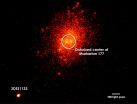Terrorist attacks decrease fertility levels, says new research
2014-11-20
A new study published online today in the journal Oxford Economic Papers has found that, on average, terrorist attacks decrease fertility, reducing both the expected number of children a woman has over her lifetime and the number of live births occurring during each year.
In recent years, terrorism has grown as a significant factor affecting our lives in unforeseen ways. Much has been written regarding the causes of terrorism, yet the ramifications of prolonged exposure to terrorism are still to be thoroughly studied. This new study, carried out by Dr. Claude Berrebi ...
Queen's researchers prove for the first time that ash clouds can cross Atlantic Ocean
2014-11-20
Scientists at Queen's University Belfast have led the discovery of a volcanic ash cloud that travelled from Alaska to Northern Ireland and beyond - overturning previously held assumptions about how far ash deposits can drift, with major implications for the airline industry.
The discovery, which was made in partnership with an international team of academics and has been published in the journal Geology, is the first evidence that ash clouds can travel across the Atlantic Ocean, confirming Queen's as a global leader in research. This particular ash, found in sites across ...
Researchers identify biological indicator of response to new ovarian cancer drug
2014-11-20
Barcelona, Spain: Researchers have found a way of identifying which ovarian cancer patients are likely to respond well to a new anti-cancer drug called rucaparib.
Results of clinical trials have shown that women with tumours that are sensitive to platinum-based chemotherapy and who carry inherited mutations in the BRCA1/2 genes respond well to rucaparib. But in new findings presented today (Thursday) at the 26th EORTC-NCI-AACR [1] Symposium on Molecular Targets and Cancer Therapeutics in Barcelona, Spain, researchers say that they have identified a biological indicator ...
Researchers pioneer new approach to treating HPV-related cervical cancer
2014-11-20
Barcelona, Spain: A drug that is already well established as a treatment for infection of the retina in people with AIDS has been shown, for the first time, to sensitise cervical cancer to chemotherapy and radiotherapy without an increase in toxic side-effects.
Cidofovir is an anti-viral drug that is effective against several viruses, including the human papilloma virus (HPV), which is implicated in the onset of cervical cancer. It targets the cancer-causing proteins (oncoproteins) produced by HPV. These oncoproteins interfere with the action of other proteins that control ...
Response to new drug in patients with lymphomas and advanced solid tumors
2014-11-20
Barcelona, Spain: Patients with B-cell Non-Hodgkin lymphomas and advanced solid tumours have responded to a new drug that is being tested for the first time in humans in a phase I clinical trial.
Preliminary results from the trial will be presented today (Thursday) at the 26th EORTC-NCI-AACR [1] Symposium on Molecular Targets and Cancer Therapeutics in Barcelona, Spain. They show responses in four lymphoma patients who have failed numerous previous treatments and also in one patient with a cancer for which there is no approved medical treatment at all - a malignant rhabdoid ...
Bad marriage, broken heart?
2014-11-20
EAST LANSING, Mich. --- Older couples in a bad marriage -- particularly female spouses -- have a higher risk for heart disease than those in a good marriage, finds the first nationally representative study of its kind.
The findings suggest the need for marriage counseling and programs aimed at promoting marital quality and well-being for couples into their 70s and 80s, said lead investigator Hui Liu, a Michigan State University sociologist.
"Marriage counseling is focused largely on younger couples," said Liu, associate professor of sociology. "But these results show ...
Pac-Man instead of patch: Using video games to improve lazy eye, depth perception
2014-11-20
WASHINGTON, D.C. - Scientists have created video games that add an important element of fun to the repetitive training needed to improve vision in people - including adults - with a lazy eye and poor depth perception.
The training tools, including a Pac-Man-style "cat and mouse" game and a "search for oddball" game, have produced results in pilot testing: Weak-eye vision improved to 20/20 and 20/50 in two adult research participants with lazy eyes whose vision was 20/25 and 20/63, respectively, before the training began.
Unlike the common use of eye patches on dominant ...
The Affordable Care Act in Kentucky, one year later
2014-11-20
LOUISVILLE, Ky. - One year ago, Michael Stillman, M.D., and his colleague, Monalisa Tailor, M.D., both physicians with the University of Louisville Department of Medicine, wrote a New England Journal of Medicine "Perspective" article about "Tommy Davis," their pseudonym-named patient who delayed seeing a doctor because he lacked health insurance.
After spending a year experiencing severe abdominal pain and other symptoms, Davis finally sought care in the emergency room. The diagnosis? Metastatic colon cancer.
"If we'd found it sooner," Davis said to the physicians, ...
A signature for success
2014-11-20
November 19, 2014, New York, NY - A team led by Ludwig and Memorial Sloan Kettering (MSK) researchers has published a landmark study on the genetic basis of response to a powerful cancer therapy known as immune checkpoint blockade. Their paper, in the current issue of the New England Journal of Medicine, describes the precise genetic signatures in melanoma tumors that determine whether a patient will respond to one such therapy. It also explains in exquisite detail how those genetic profiles translate into subtle molecular changes that enable the immune system attack of ...
New leadless pacemaker safe, reliable
2014-11-19
A new self-contained leadless cardiac pacemaker is a safe and reliable alternative to conventional pacemakers, according to research presented at the American Heart Association's Scientific Sessions 2014.
The new device reduces complications that have existed over the last 50 years that are associated with lead placement and performance and the pulse generator situated under the skin that have occurred with conventional pacemaker systems.
In the first trial of the leadless pacemaker, doctors implanted one in eight patients (average 82 years old, 75 percent men) with ...
More children surviving dilated cardiomyopathy without heart transplant
2014-11-19
More children with dilated cardiomyopathy are surviving without a heart transplant, according to research presented at the American Heart Association's Scientific Sessions 2014.
Dilated cardiomyopathy occurs when the heart is enlarged (dilated) and the pumping chambers contract poorly (usually left side is worse than right). It can have genetic and infectious/environmental causes.
Researchers analyzed the clinical outcomes of children with dilated cardiomyopathy in the NHLBI Pediatric Cardiomyopathy Registry (PCMR) and divided them into two groups based upon year of ...
Unhealthy behavior may be cross-generational
2014-11-19
Children whose parents spend a lot of time sitting in front of a computer or other screen are more likely than other children to have excessive screen-time habits, as well as associated risks for heart and blood vessel disease, according to a study presented at the American Heart Association's Scientific Sessions 2014.
"Screen time of children is significantly associated with parental screen time," said Masao Yoshinaga, M.D., Ph.D., the study's lead author and chief director of pediatrics at National Hospital Organization, Kagoshima Medical Center in Japan. "To reduce ...
From architect to social worker: Complex jobs may protect memory and thinking later on
2014-11-19
MINNEAPOLIS - People whose jobs require more complex work with other people, such as social workers and lawyers, or with data, like architects or graphic designers, may end up having longer-lasting memory and thinking abilities compared to people who do less complex work, according to research published in the November 19, 2014, online issue of Neurology®, the medical journal of the American Academy of Neurology.
"These results suggest that more stimulating work environments may help people retain their thinking skills, and that this might be observed years after ...
Johns Hopkins scientists present findings at the Society for Neuroscience meeting
2014-11-19
Nanosymposium 18.10
Sat., 3:15 p.m., Walter E. Washington Convention Center, 150A
Lindsay Hayes and Akira Sawa
A Blood Pressure Hormone Implicated in Psychosis
In an effort to find a marker that predicts psychosis, postdoctoral researcher Lindsay Hayes, Ph.D., learned unexpectedly that mice and people with behavior disorders have abnormally low levels of a hormone system tied to blood pressure regulation and inflammation. In the cerebrospinal fluid of patients with first episode psychosis, she noticed abnormally low levels of the enzyme that makes the hormone angiotensin. ...
Laser for tattoo removal appears to improve facial acne scarring
2014-11-19
A laser used to remove unwanted tattoos appears to improve facial acne scarring, according to a study published online by JAMA Dermatology.
Acne and subsequent scarring can have psychological effects. Lasers are used in the treatment of acne scarring. The U.S. Food and Drug Administration has approved the use of a 755-nm picosecond alexandrite laser, , a technology that delivers lower doses of energy theoretically leading to fewer adverse events, for the treatment of unwanted tattoos.
Jeremy A. Brauer, M.D., of the Laser & Skin Surgery Center of New York, and his co-authors ...
Telemedicine collaborative care for posttraumatic stress disorder in US veterans
2014-11-19
Military veterans with posttraumatic stress disorder (PTSD) who live in rural areas successfully engaged in evidence-based psychotherapy through a telemedicine-based collaborative care model thereby improving their clinical outcomes, according to a report published online by JAMA Psychiatry.
A disabling disorder, PTSD develops in some people exposed to traumatic events. More than 500,000 military veterans enrolled in the Veterans Health Administration (VHA) health care system (about 9.2 percent of the VHA population) were diagnosed with PTSD in 2012. A large portion of ...
Study examines national trends in mastectomy for early-stage breast cancer
2014-11-19
Higher proportions of women eligible for breast conservation surgery (BCS) are undergoing mastectomy, breast reconstruction and bilateral mastectomy (surgical removal of both breasts), with the steepest increases seen in women with lymph node-negative and in situ (contained) disease, according to a report published online by JAMA Surgery.
BCS has been a standard of excellence in breast cancer care and its use for management of early-stage breast cancer had increased steadily since the 1990s. However there is evidence that that trend may be reversing.
Kristy L. Kummerow, ...
Eighty percent of kidney dialysis patients unprepared for natural disaster or emergency
2014-11-19
MAYWOOD, Ill. - Eighty percent of kidney dialysis patients surveyed were not adequately prepared in the event of an emergency or natural disaster that shut down their dialysis center.
But after receiving individualized education from a multidisciplinary team of doctors, nurses, dieticians and social workers, 78 percent of these patients had become adequately prepared, according to a Loyola University Medical Center study.
Anuradha Wadhwa, MD, and colleagues, reported findings during the ASN Kidney Week 2014 meeting.
Patients with kidney failure rely on dialysis treatments ...
UTMB scientist finds marker that predicts cholesterol level changes as people grow older
2014-11-19
It's known that cholesterol levels typically rise as people age and that high cholesterol levels are associated with increased risk of cardiovascular disease. What's less known is that cholesterol levels begin to decline the more a person ages. Recently, researchers from the University of Texas Medical Branch at Galveston and the University of Kentucky found that differences in one gene can influence a person's cholesterol levels from midlife to late life.
The study, published in the International Journal of Environmental Research and Public Health, analyzed data from ...
Crops play a major role in the annual CO2 cycle increase
2014-11-19
MADISON, Wis. -- Each year, the planet balances its budget. The carbon dioxide absorbed by plants in the spring and summer as they convert solar energy into food is released back to the atmosphere in autumn and winter. Levels of the greenhouse gas fall, only to rise again.
But the budget has gotten bigger. Over the last five decades, the magnitude of this rise and fall has grown nearly 50 percent in the Northern Hemisphere, as the amount of the greenhouse gas taken in and released has increased. Now, new research shows that humans and their crops have a lot to do with ...
NASA's Swift mission probes an exotic object: 'Kicked' black hole or mega star?
2014-11-19
An international team of researchers analyzing decades of observations from many facilities, including NASA's Swift satellite, has discovered an unusual source of light in a galaxy some 90 million light-years away.
The object's curious properties make it a good match for a supermassive black hole ejected from its home galaxy after merging with another giant black hole. But astronomers can't yet rule out an alternative possibility. The source, called SDSS1133, may be the remnant of a massive star that erupted for a record period of time before destroying itself in a supernova ...
Digging for answers
2014-11-19
On an archaeology field trip in New Mexico as an undergraduate in 2006, Dana Bardolph noticed something that struck her as an odd gender imbalance: The professor leading the dig was a men, while the graduate assistant and all but two of the 14 undergrads were women.
"And it just got me thinking," Bardolph recalled. "Is this reflective of the profession as a whole, or is it an anomaly?"
The question stayed with her, and four years ago she decided to search for an answer. Her findings -- generated after digging through more than 4,500 peer-reviewed papers in 11 archaeology ...
Two new baryon particles discovered in agreement with York U prediction
2014-11-19
TORONTO, November 19, 2014 - Today an international team of researchers announced the discovery of two new particles in the baryon family, which makes them cousins of the familiar proton and neutron. The LHCb collaboration at CERN, the European Organization for Nuclear Research, used CERN's Large Hadron Collider to make these discoveries.
The masses of these particles, named Xi_b'- and Xi_b*- had been predicted in a paper published in 2009 by York University Professor Randy Lewis and Richard Woloshyn, scientist at the TRIUMF Lab in Vancouver, using a supercomputer approach ...
Vanderbilt study finds more breast cancer patients opting for mastectomy
2014-11-19
Far more breast cancer patients are choosing to undergo mastectomy, including removal of both breasts, instead of choosing breast conservation surgery even when they have early stage disease that is confined to one breast, a Vanderbilt study shows. In the past decade, there have also been marked trends toward higher proportions of women opting for breast reconstruction.
The rates of increase were steepest among women with lymph node-negative and in situ (contained) disease.
This is a reversal of trends seen since the 1990s when breast conservation surgery (BCS) was ...
Delivering stem cells into heart muscle may enhance cardiac repair and reverse injury
2014-11-19
Delivering stem cell factor directly into damaged heart muscle after a heart attack may help repair and regenerate injured tissue, according to a study led by researchers from Icahn School of Medicine at Mount Sinai presented November 18 at the American Heart Association Scientific Sessions 2014 in Chicago, IL.
"Our discoveries offer insight into the power of stem cells to regenerate damaged muscle after a heart attack," says lead study author Kenneth Fish, PhD, Director of the Cardiology Laboratory for Translational Research, Cardiovascular Research Center, Mount Sinai ...
[1] ... [3064]
[3065]
[3066]
[3067]
[3068]
[3069]
[3070]
[3071]
3072
[3073]
[3074]
[3075]
[3076]
[3077]
[3078]
[3079]
[3080]
... [8709]
Press-News.org - Free Press Release Distribution service.



